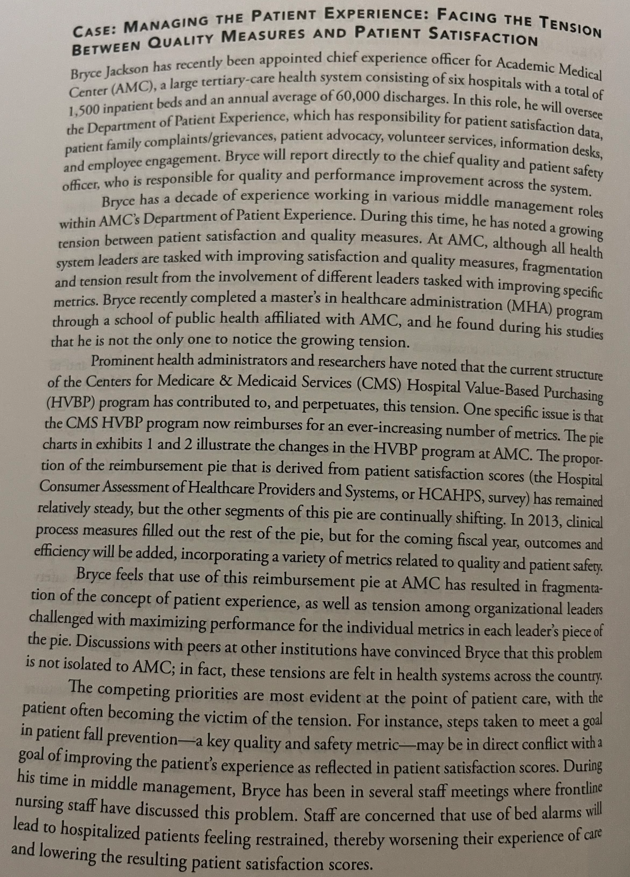Managing the Patient Experience case: Identify and describe performance improvement terms, concepts, tools, and methods from chapter 12 that are evident in this case.
Managing the Patient Experience case: Identify and describe performance improvement terms, concepts, tools, and methods from chapter 12 that are evident in this case.
Chapter1: Overview Of Coding
Section: Chapter Questions
Problem 15MC
Related questions
Question
4. Managing the Patient Experience case: Identify and describe performance improvement terms, concepts, tools, and methods from chapter 12 that are evident in this case.

Transcribed Image Text:CASE: MANAGING THE PATIENT EXPERIENCE: FACING THE TENSION
BETWEEN QUALITY MEASURES AND PATIENT SATISFACTION
Center (AMC), a large tertiary-care health system consisting of six hospitals with a total of
Bryce Jackson has recently been appointed chief experience officer for Academic Medical
1,500 inpatient beds and an annual average of 60,000 discharges. In this role, he will oversee
the Department of Patient Experience, which has responsibility for patient satisfaction data,
and employee engagement. Bryce will report directly to the chief quality and patient safety
patient family complaints/grievances, patient advocacy, volunteer services, information desks,
officer, who is responsible for quality and performance improvement across the system.
Bryce has a decade of experience working in various middle management roles
within AMC's Department of Patient Experience. During this time, he has noted a growing
tension between patient satisfaction and quality measures. At AMC, although all health
system leaders are tasked with improving satisfaction and quality measures, fragmentation
and tension result from the involvement of different leaders tasked with improving specific
metrics. Bryce recently completed a master's in healthcare administration (MHA) program
through a school of public health affiliated with AMC, and he found during his studies
that he is not the only one to notice the growing tension.
propor-
Prominent health administrators and researchers have noted that the current structure
of the Centers for Medicare & Medicaid Services (CMS) Hospital Value-Based Purchasing
(HVBP) program has contributed to, and perpetuates, this tension. One specific issue is that
the CMS HVBP program now reimburses for an ever-increasing number of metrics. The pie
charts in exhibits 1 and 2 illustrate the changes in the HVBP program at AMC. The p
tion of the reimbursement pie that is derived from patient satisfaction scores (the Hospital
Consumer Assessment of Healthcare Providers and Systems, or HCAHPS, survey) has remained
relatively steady, but the other segments of this pie are continually shifting. In 2013, clinical
process measures filled out the rest of the pie, but for the coming fiscal year, outcomes and
efficiency will be added, incorporating a variety of metrics related to quality and patient safety.
Bryce feels that use of this reimbursement pie at AMC has resulted in fragmenta-
tion of the concept of patient experience, as well as tension among organizational leaders
challenged with maximizing performance for the individual metrics in each leader's piece of
the pie. Discussions with peers at other institutions have convinced Bryce that this problem
is not isolated to AMC; in fact, these tensions are felt in health systems across the country.
The competing priorities are most evident at the point of patient care, with the
patient often becoming the victim of the tension. For instance, steps taken to meet a goal
in patient fall prevention a key quality and safety metric-may be in direct conflict with a
goal of improving the patient's experience as reflected in patient satisfaction scores. During
his time in middle management, Bryce has been in several staff meetings where frontline
nursing staff have discussed this problem. Staff are concerned that use of bed alarms will
lead to hospitalized patients feeling restrained, thereby worsening their experience of care
and lowering the resulting patient satisfaction scores.
Expert Solution
This question has been solved!
Explore an expertly crafted, step-by-step solution for a thorough understanding of key concepts.
This is a popular solution!
Trending now
This is a popular solution!
Step by step
Solved in 2 steps

Recommended textbooks for you


Understanding Health Insurance: A Guide to Billin…
Health & Nutrition
ISBN:
9781337679480
Author:
GREEN
Publisher:
Cengage


Understanding Health Insurance: A Guide to Billin…
Health & Nutrition
ISBN:
9781337679480
Author:
GREEN
Publisher:
Cengage